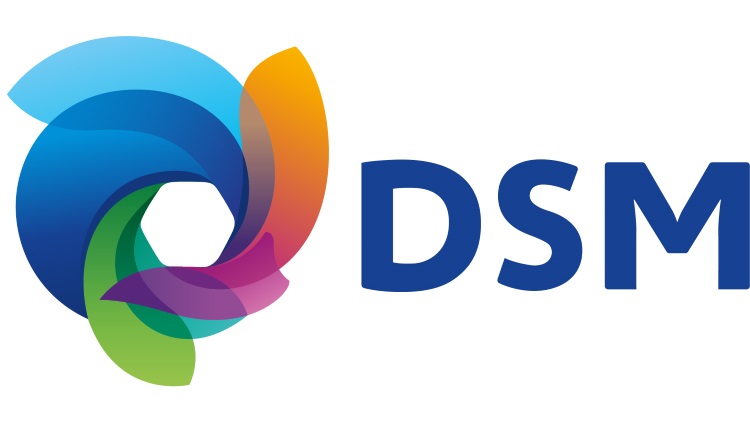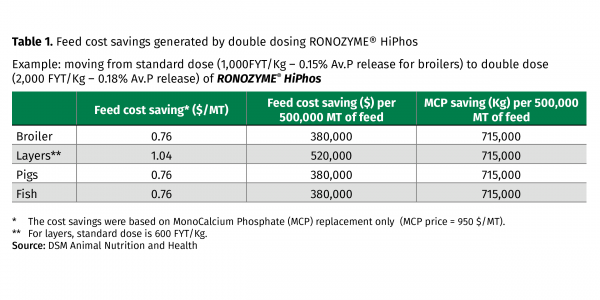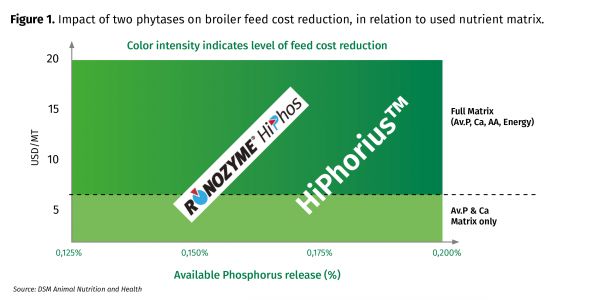Promotional Features
Science supports further opportunities for feed cost reduction
by Kostas Stamatopoulos, Senior Global Category Manager at DSM Animal Nutrition and Health
Though high prices of feed ingredients have turned greater attention to feed enzymes, feed producers and integrators may not be getting the full feed cost reduction benefits from their current application.
Market conditions for corn (maize), wheat, soyabean meal and phosphates have encouraged nutritionists to explore new ways to optimize their feeds. The use of feed enzymes is a well-established practice over the last 25 years, and most feeds for poultry, swine and farmed aquatic species contain feed enzymes.
Here we provide an overview of how to achieve the greatest feed cost savings using the three main categories of enzymes: phytase, protease and carbohydrase.
Benefits of feed enzymes beyond nutrient utilization
The need to efficiently utilize nutrients is the principal rationale for the use of feed enzymes in monogastric animal diets. However, the benefits of enzyme supplementation go beyond nutrient (phosphorus, protein, starch) utilization, including:
- Increased flexibility for alternative feed ingredients. Feed enzymes can remove constraints for the inclusion of poorly digested ingredients.
- Improved feed quality. Feed enzymes can reduce the variation between good and low quality lots of a given feed ingredient, resulting in more consistent feed.
- Eubiosis. Enzymes encourage a shift of gut microbiota towards favorable bacterial species, which contributes to better gut health.
- Reduced emissions. More complete nutrient utilization results in lower environmental emissions.
Phytase for better phosphorus utilization
Phytase, the most used feed enzyme, acts upon phytate which stores plant phosphorus. Phytate phosphorus is unavailable to poultry, swine and fish and acts as an anti-nutritional factor by forming complexes with minerals such as calcium, zinc iron, etc., and proteins.
Phytase greatly increases the amount of dietary phosphorus available to animals by breaking down the antinutrient phytate, releasing phosphorus and other nutrients, and making them available to the animal. This means that far lower levels of inorganic phosphorus need to be added into the diet, delivering substantial savings on feed costs, and reducing the need for supplementary inorganic phosphate use.
To get the most benefit from phytase, nutritionists should consider the following tips for success.
Phytase Tip 1. Select for thermal stability. Choosing a phytase like RONOZYME HiPhos or HiPhorius (for markets that it is available) with exceptional pelleting stability ensures that the product will arrive active in animals’ gastrointestinal tracts and will help maximize phytate degradation.
Phytase Tip 2. Move from standard to higher dose
For those in the feed industry using a standard phytase dose, moving to a higher dose can give some significant additional cost benefits and help reduce inorganic phosphate usage (Table 1).
Table 1. Feed cost savings generated by double dosing RONOZYME HiPhos | Source: DSM Animal Nutrition and Health
Phytase Tip 3. Use a third or fourth-generation phytase
For producers already using phytase, upgrading to a more advanced phytase will deliver faster and more efficient results. HiPhorius provides at least 20% more phosphorus release at the same standard dose compared to third-generation phytase products.
Tip 4. Use phytate-phosphorus NIR service
Phytate phosphorus levels in commonly used raw materials vary markedly, so using average book values in formulations runs the risk of an incorrect phytase dosage.
DSM has developed robust phytate-P NIR equations for both ingredients and complete feed to allow rapid and cost-effective phytate-P amount measurement in each sample, ensuring you have the required amount of substrate for the phytase proposed dose. Contact your DSM representative for more information.
Phytase Tip 5. Use a web tool to explore dietary scenarios
A few other factors can influence phytase efficacy. With the DSM RONOZYME HiPhos Web Matrix Calculator you can evaluate the impact of different dietary scenarios on the accessibility of phytate in different species and what this means for phytase dosing.
Phytase Tip 6. Check for amino acid digestibility in nutrient matrix value tables
Effects of phytase on nutrients such as amino acids, trace minerals and energy are not consistently reported in the literature or exploited by nutritionists. DSM carried out two meta-analyses (Cowieson et al., 2017 & Cowieson et al., 2017), analyzing peer-reviewed amino acid digestibility trials with phytase in both poultry and swine.
The main conclusions from these published evaluations were:
- While at lower phytase doses there was a direct relationship between phosphorus release and improvement in amino acid digestibility, at higher doses this relationship did not exist.
- Phytase response was significantly different for individual amino acids.
- Amino acid response patterns seen in broilers (2-6%) were different from those seen in pigs (1-4%).
The results of these meta-analyses offer clear evidence that phytase is associated with increases in ileal amino acid digestibility in both broilers and pigs. They also show the importance of scrutinizing amino acid matrix values before applying them in practical feed optimizations.
Proposed phytase matrix values that do not follow the above three bullet points should be treated with some caution.
The findings of these meta-analyses have been implemented in DSM’s phytase nutrient matrix value tables. If someone uses the full matrix (minerals, amino acids and energy) in broiler diet optimization, the feed cost reduction can improve by 1-4% in terms of cost per metric ton. (Figure 1).
Figure 1: Impact of two different generation phytases on broiler feed cost reduction, in relation to used nutrient matrix.
Protease for more protein utilization
Exogenous proteases are relative newcomers and in some sense application research and development is still catching up with the considerable growth in this feed enzyme segment.
The direct effect of exogenous protease is hydrolysis of high molecular weight polypeptides into lower molecular weight oligopeptides. The substrate for exogenous proteases is recalcitrant dietary proteins, proteinaceous antinutrients (trypsin inhibitors & beta-conglycinin) as well as dietary protein.
Hydrolysis of these proteins results in a significant increase in dietary protein digestibility (circa +4%; Cowieson & Roos, 2014), the extent of which depends on the amino acid, the raw material in question and the relative inherent quality of the protein therein.
To get the most benefit from protease, nutritionists should consider the following tips.
Protease Tip 1. Pay attention to protease effects per amino acid and per ingredient
DSM has conducted more than 120 standardized ileal amino acid digestibility (SID) studies with RONOZYME ProAct since 2008 and in all cases the dose used was the commercially recommended (200 g/MT of feed). The mean response for the most nutritionally relevant amino acids (Met, Cys, Lys, Thr, Try, Arg, Val, Ile & Leu) was +3.1% and this ranged from +1.6% for Leu to +4.8% for Cys. Various feed ingredients have been examined including cereals and their by-products, vegetable protein meals and animal protein meals. Mean responses to RONOZYME ProAct ranged from +0.2% for field beans to +6.8% for meat & bone meal, while amino acid SID improved by +3.9% in corn, by +4.4% in wheat and by +3.5% in soyabean meal.
These substantial differences on protease effects by amino acid and by feed ingredient need special attention during diet optimization. Flat amino acid improvement is likely to result in variable responses in performance. To address this, have a look at Tip 3.
Protease Tip 2. Consider energy contribution
A significant ‘extra-proteinaceous’ effect of an exogenous protease is the improvement in starch and fat digestibility. A recent meta-analysis of published work with RONOZYME ProAct on apparent metabolizable energy (AME) or ileal digestible energy (DE) revealed a mean increase of 81 kcal/Kg.
Protease Tip 3. Re-optimize diets with a customized amino acid matrix
DSM has developed a RONOZYME ProAct Web Matrix Calculator, which includes the aforementioned studies’ results into a web-calculated amino acid matrix that is customized for every diet input. Re-optimizing broiler diets with such a matrix, together with an energy contribution of 25 kcal/Kg of feed, could reduce the feed cost by 3-8 $/MT, depending on soyabean meal price.
Protease Tip 4. Upgrade to a second-generation protease
This feed cost reduction could be further improved by upgrading to the only second-generation feed protease on the market, ProAct 360 launched in 2021 and in the process of being rolled out globally. ProAct 360 is a completely new molecule that is active on a broad range of raw materials delivers 10% more performance, which translates into further cost savings beyond conventional proteases.
Carbohydrases for more energy release
Carbohydrases include exogenous amylases and NSP-degrading enzymes that can degrade fiber or the Non-Starch Polysaccharides (NSP) present in plant cell-walls, constitute another large feed enzyme segment.
The NSP enzyme sub-category includes xylanases, beta-glucanases, pectinases, cellulases, xyloglucanases and arabinoxylan debranching enzymes such as arabinofuranosidases.
NSP enzymes degrade soluble fiber, reduced gut viscosity and improved nutrient absorption. They also solubilize insoluble fiber and liberate nutrients from plant endosperm cells.
Amylases, another sub-category of carbohydrase, improve starch digestibility. Corn’s starch digestibility is typically at 85-95%, leaving space for improvement with an exogenous amylase, especially for fast-growing modern broiler breeds, where the excretion of pancreatic amylase is limited during grower and finisher phases, while dietary starch intake is higher.
Carbohydrase Tip 1. Use more from carbohydrases
Carbohydrases are used by nutritionists either ‘on top’ or with a low energy contribution (20-40 Kcal/Kg of feed), leaving most of the carbohydrase effect to be used as a ‘safety margin’.
The variety of carbohydrases available to nutritionists offers multiple opportunities to extract more value from both fiber and starch.
At current feed prices, improved carbohydrase use and energy contribution could deliver 4-9 $/MT in savings.
Carbohydrase Tip 2. Evaluate your substrate (Fiber-starch)
NSP levels and starch quality in commonly used raw materials vary markedly. DSM is developing NSP- and starch-NIR equations for both ingredients and complete feed to allow rapid and cost-effective evaluation of the NSP structures and starch fractions, ensuring you have the required amount of substrate for the carbohydrase enzyme proposed dose.
Carbohydrase Tip 3. Select the right carbohydrase for maximum benefit
DSM has a wide carbohydrase portfolio, which can extract value from cereal fiber, (RONOZYME MultiGrain, RONOZYME WX2,000), non-cereal fiber (RONOZYME VP) and starch (RONOZYME HiStarch).
Conclusion
As highlighted by Cowieson (2014), the way feed enzymes are included in least cost formulations can profoundly influence their value, particularly when focus is given only to minimizing feed cost, while disregarding animal performance. Indiscriminate use of feed enzymes may result in inconsistent effects at animal level, and it is suggested that enzyme value to be divided[1] across feed cost reduction and animal performance. Good knowledge on enzyme application is very important to optimize the feed enzyme value.



